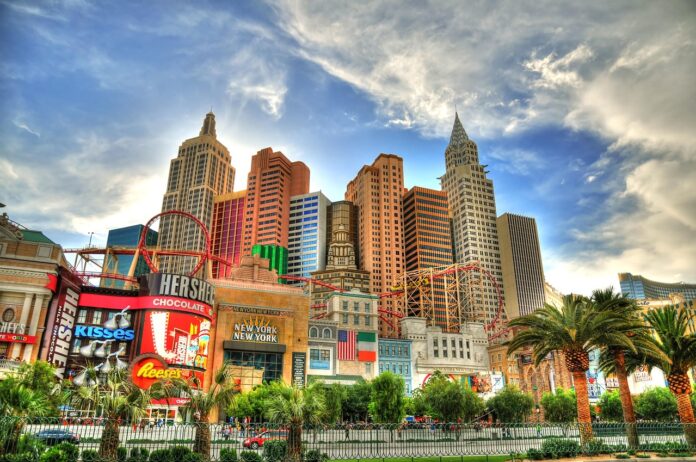Back in 1900, Las Vegas wasn’t the casino empire it’s known for. It had exactly 30 residents – but today, the city pulls in 42 million visitors who drop billions at casinos that dominate the skyline. Yet such a transformation didn’t happen by accident – seven entrepreneurs with questionable ethics and deep pockets literally invented modern Vegas.
William Clark Started It All With a $960,000 Land Grab in 1905
William Andrews Clark saw what nobody else did: a perfect maintenance stop for his Los Angeles-Salt Lake railroad. This Montana copper king, who was worth more money than anyone except Rockefeller, bought up land and auctioned off 1,200 lots in a single day in 1905. Clark built the first casino right at his railroad depot. So, he dug wells, ran pipelines from the springs, and basically made a town from scratch.
Clark didn’t care about gambling, though. He wanted to sell land and move trains, but his infrastructure made everything else possible. The county still carries his name, and without his railroad bringing in workers and tourists, Vegas stays a desert outpost with tumbleweeds and not much else. Certainly not the casino empire known today.
Thomas Hull took the next big step in 1941. His El Rancho Vegas cost $500,000 and sat right on what became the Strip – and with 110 rooms, it seemed huge at the time. Hull added something new – entertainment that had nothing to do with cards or dice. His resort had horseback riding, a swimming pool, and even an opera house. Every Vegas resort that came after copied this formula: give people more reasons to stay than just gambling.
Bugsy Siegel’s $6 Million Disaster Changed Everything in 1946
Benjamin “Bugsy” Siegel gets credit for creating the modern Vegas casino empire, though he actually hijacked someone else’s project. Billy Wilkerson started building the Flamingo but ran out of cash, while Siegel muscled in with mob money and took over. The budget exploded from $1 million to $6 million – which would be about $72 million today. Contractors literally stole supplies at night and sold them back to Siegel the next morning – he paid black market prices for everything.
The Flamingo’s opening on December 26, 1946, flopped hard. A rainstorm kept celebrities away, and the casino lost $300,000 in the first week because gamblers had nowhere to sleep, so they took their winnings and gambled at competitors’ hotels. Siegel shut down after two weeks, reopened in March 1947, and finally started making money. By May, the casino showed a $300,000 profit.
Howard Hughes Bought Vegas Legitimacy for $300 Million
Hughes rolled into Vegas on Thanksgiving 1966 and checked into the Desert Inn penthouse. When management asked him to leave for New Year’s guests, Hughes bought the whole hotel. Then he went shopping: the Sands, New Frontier, Landmark, Castaways, plus TV stations and radio stations – and he spent more than $300 million in Vegas real estate.
The eccentric billionaire never left his casino empire penthouse, running everything through his Mormon assistants. But his presence was more important than his management. When Howard Hughes owned casinos, Wall Street paid attention.
Today’s gambling sphere looks nothing like Hughes’s era. Players now skip the Vegas trip entirely, choosing online platforms that have better odds and zero travel costs. Crypto casinos changed it all completely – they process billions in bets annually, and players love the anonymity. For anyone who is curious about such a change, the key takeaways about modern crypto gambling show why younger gamblers rarely visit physical casinos anymore.
Kirk Kerkorian Built and Destroyed the World’s Biggest Hotel Three Times
Kerkorian makes other Vegas moguls look conservative. Well, this Armenian immigrant’s son built the International Hotel in 1969 with 1,512 rooms – world’s biggest one. Then came the original MGM Grand in 1973 with 2,000 rooms – the world’s biggest once again. A horrific fire killed 85 people in 1980, but Kerkorian rebuilt. His 1993 MGM Grand had 5,005 rooms and a casino the size of two football fields – and yes, world’s biggest for the third time.
At his peak in 2008, Kerkorian was worth $16 billion. The recession knocked him down to $3 billion, but he never stopped building. MGM Resorts International, the company he made, now owns the Bellagio, Luxor, Mandalay Bay, Excalibur, and properties from Massachusetts to Macau – with a total value of $13.6 billion.
Steve Wynn Invented the Modern Megaresort with Junk Bonds
Wynn made a turn in 1989 with The Mirage – the first casino built with Wall Street money instead of mob cash. He sold $630 million in junk bonds to finance 3,044 rooms with gold-tinted windows. The volcano out front, the white tigers, the dolphins – Wynn understood people wanted fantasy in the casino empire.
Before Wynn, Vegas hotels made money from gambling – but Wynn flipped that model. He brought in permanent Cirque du Soleil shows, celebrity chef restaurants, luxury shopping…
Sheldon Adelson Turned $110 Million Into $35 Billion
Adelson started selling newspapers at age 12 in Boston’s slums. He created the COMDEX computer trade show and sold it for $862 million in 1995, personally pocketing $500 million. Also, he bought the old Sands for $110 million in 1988, tore it down, and spent $1.5 billion building The Venetian in 1999. Every room was a suite. The attached convention centers targeted business travelers, not gamblers.
But Adelson’s real genius showed in Asia – his Sands Macao opened in 2004 for $265 million and paid for itself in under a year. Adelson’s net worth hit $35 billion before his death in 2021, making him one of the 20 richest Americans.
The Killers, Mobsters, and Billions That Built Modern Vegas
Well, these seven men didn’t play nice – Siegel was a founding member of Murder, Inc. and personally killed over 30 people. Kerkorian was a professional boxer who’d fight anybody over business deals. Hughes used his billions to bully competitors, while Adelson destroyed unions and crushed rivals with lawsuits.
But they built something incredible. Vegas went from 30 people in 1900 to hosting 42 million visitors each year. The casino empire brings in more than $13 billion yearly, and the convention business adds billions more – also, employment hit 450,000 people in the metro area.
Not bad for a desert town nobody wanted.
Find a Home-Based Business to Start-Up >>> Hundreds of Business Listings.

















































